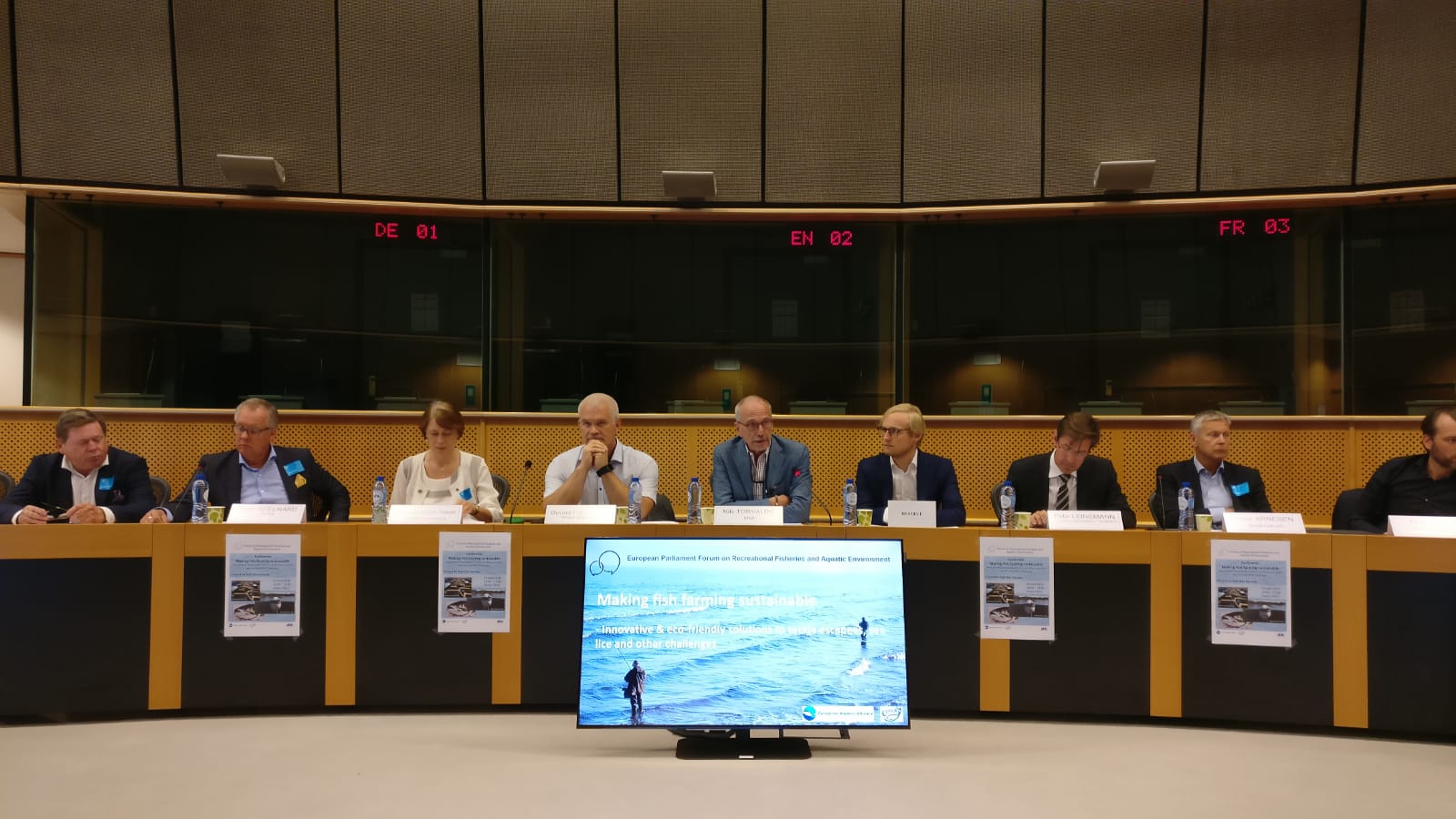The growth of fish farming will increase the negative impacts on the marine environment and rivers. More environmentally friendly production methods need to be put in place. This was the main take-home message from a conference held in the European Parliament. Various closed-containment aquaculture systems were showcased. These environmentally friendly systems become more and more cost competitive due to high and increasing cost for traditional open net farms production with regard to escaped fish, predators and sea lice and diseases treatment.
The event, entitled “Making fish farming sustainable - Innovative & eco-friendly solutions to tackle escapees, sea lice and other challenges”, took place on the 26th of June and was organised by the Forum on Recreational Fisheries and Aquatic Environment, supported by the European Anglers Alliance (EAA) and the European Fishing Tackle Trade Association (EFTTA).
Conventional aquaculture in pens or net cages creates severe risks to the surrounding marine environment and to wild fish stocks, especially to species like salmon and sea trout. Norway is a world leader in salmon farming. They produce more farmed fish than EU combined. Norway also has some visionary fish farm companies taking the lead on sustainable fish farming. Therefore, two speakers from Norway were invited to the panel, one from the angling community and one from the industry to bring us up to date on fish farming in Norway, problems, technical solutions and strategies.

Øyvind Fjeldseth, biologist from EAA’s Norwegian member organisation ’Norges Jeger- og Fiskerforbund’, stressed, that wild fish stocks are exposed to two major threats from fish farming; namely escapees and sea lice. When fish escape farms they can interfere with the wild fish spawning process. Over time, interbreeding between farmed and wild fish lead to diluted quality of the wild stocks threatening them with extinction. It is estimated for Norway, that escaped salmon have already affected the genetic integrity of 66% of 175 surveyed salmon stocks. Mortality caused by sea lice is 18% on average for salmon and 20-30% for Sea trout. Sea lice become deadly in large numbers, especially for young fish. An increase in fish farms means an increase in sea lice hosts, too. The solutions employed today, chemical treatment and cleaning fish (wrasse), are far from being effective enough.
MEP Nils Torvalds, the chair of the event, stressed the importance of striking a balance between the further development of the aquaculture sector and the protection of the environment.
Dr. Petter Arnesen from the Federation of Norwegian Industries introduced “Roadmap of the Norwegian aquaculture sector – sustainable growth”. Their vision is “that Norwegian salmon farming will become the most efficient and environmentally friendly protein production industry in the world.”
Innovation and new regulatory measures are needed as the growth of the farmed salmon today is restricted by the salmon lice and escapees problems, and in future possibly restricted by viral diseases (need for effective vaccines), feed raw materials (need to develop new sources) and ocean space (need for new farm sites). Production cost has increased by 40% between 2012 and 2016, with no production increase in the same period.
Norway is implementing a “Traffic Light System”, (green, yellow, red), which tells which areas of Norway can sustain more fish farming (green areas), status quo (yellow areas) and where production reduction is required (red areas). The system is based on sea lice concentrations.
The industry’s Roadmap aims to achieve escape proof installations by 2024 and lice free installations by 2027. Technological innovations will be the key to sustainable development and will change the face of aquaculture facilities by creating ocean farms, sub-sea and closed and semi-closed containment systems.
Fully closed systems at land or at sea effectively address all negative impacts generated by fish farming as they put effective barriers between the farmed fish and the natural environment, and clean the water used. From a cost perspective, these systems require big investments as their establishment and management are generally expensive. Nonetheless, more and more businesses across Europe are demonstrating that these kinds of solutions can be economically viable. The marketing of environmental sustainable fish farming is very important. If the consumers are fully aware of the non-environmental impact they highly likely also will be willing to pay a little extra for the product.
The conference brought examples of Atlantic Sapphire and FIFAX, two EU-based companies that produce Atlantic salmon and rainbow trout through closed aquaculture recirculation systems, which provide healthy food produced environmental-friendly.
The EU is determined to increase its domestic aquaculture production in order to lower dependence on imports of seafood from third countries.
Felix Leinemann of DG MARE, European Commission, encouraged Member States to facilitate open dialogues among stakeholders on this topic at both national and regional level. He also recalled that there are several EU funds available to support the establishment of sustainable and green aquaculture systems and that Member States have an important role to play as they set their own strategic objectives.
EAA and EFTTA comment: We are very concerned about an increase in negative consequences from a “business-as-usual” approach. Conventional aquaculture in Europe already has too much negative impact on wild fish stocks and the marine environment. The EAA and the EFTTA support a gradual transition to closed systems at sea or on land in order to reduce the genetic impact of escaped salmon on wild population, to reduce fish mortality due to sea lice and to reduce effluents from the fish farms of nutrients, faeces, chemicals and medicines. The proposal for a new, or revised, European Maritime and Fisheries Fund (EMFF) for the budget period 2021-2027 is pending. EAA and EFTTA strongly request our policy-makers to allocate more resources to the development of closed-containment fish farming systems.